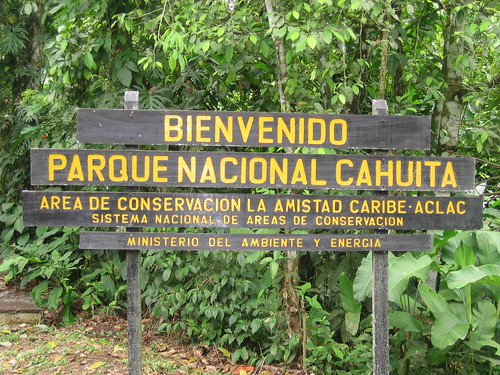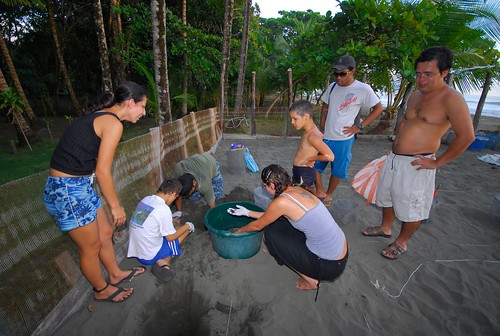The Ostional Wildlife Refuge in Costa Rica is where tens of thousands of sea turtles congregate and nest
in a massive and synchronous fashion, known as the “arribada”, the Spanish word for arrival. The turtle
educational program in Ostional was developed in 1987 to create a balance between the environment
and the socioeconomic needs of the community. Through a program developed by the Ostional Development Association and approved by the Costa
Through a program developed by the Ostional Development Association and approved by the Costa
Rican Institute for Fishing and Aquaculture (INCOPESCA) and the Ministry of the Environment, Energy
and Telecommunications (MINAET), the community of Ostional has been allowed to harvest a certain
portion of the sea turtle eggs. This Management Plan was designed and based upon the best scientific
evidence available at the time (Cornelius et al., 1992), which suggested that the harvesting of a certain
portion of eggs would not impact hatching success rates nor net neonate production, while it does
improve the economic situation of the community of Ostional, a strong incentive to the responsible
management of the resource. The project was also considered a contribution to the struggle against the
illegal harvest of sea turtles eggs from other beaches and that are sold in clandestine. The social
economic success of this project was a well accepted fact by the local community, the authorities and
sea turtle conservationist community in general.
After 11 years of controlled harvest, a general concern existed among local authorities and the
international scientific community regarding the biological implications of this legal egg harvest and the
impact on the nesting population, especially considering the lack of technical reports and scientific
publications since the legal harvest was approved in 1987. It is generally accepted that the harvest of
olive ridley sea turtle eggs is permissible if the adult population is stable and enough eggs are protected
to ensure a healthy production of hatchlings. As a result, a study was conducted in 1997 to determine if the harvest of eggs had impacted the nesting
As a result, a study was conducted in 1997 to determine if the harvest of eggs had impacted the nesting
population. This review was submitted to the authorities of INCOPESCA and MINAET in December of the
same year. Through a series of studies they found that the Ostional nesting population of olive ridley sea
turtles varies within normal parameters, and there is no statistical evidence to suggest that the number
of nesting adults is increasing or decreasing. In other words, we could say that current egg harvest levels
do not negatively impact hatchling production. In 2007 MINAET and INCOPESCA, in conjunction with the Costa Rica National Parks System (SINAC), The
In 2007 MINAET and INCOPESCA, in conjunction with the Costa Rica National Parks System (SINAC), The
Association for the Integral Development of Ostional (ADIO) and the College of Biological Studies for the
University of Costa Rica (UCR), built a five-year plan that would continue to protect the well-being and
ecosystems of the approximately four million turtles which hatch each year and would, at the same
time, favor the more than 120 families of Ostional who would be helping to protect them.
It is important to understand that the nature of this project is one that calls for a balance between
society and environment and serves as an educational tool for the surrounding community to learn
more about the importance of conserving this species.
If you wish to obtain more information regarding this project and its results please contact:
Lic. Norma Rodríguez Garro, Director of Protected Areas (SINAC), (506) 2659-9311/ 2659-9369
For press inquiries, please contact 1-888-600-6806 or e-mail VisitCostaRicaPress@bm.com
in a massive and synchronous fashion, known as the “arribada”, the Spanish word for arrival. The turtle
educational program in Ostional was developed in 1987 to create a balance between the environment
and the socioeconomic needs of the community.
 Through a program developed by the Ostional Development Association and approved by the Costa
Through a program developed by the Ostional Development Association and approved by the CostaRican Institute for Fishing and Aquaculture (INCOPESCA) and the Ministry of the Environment, Energy
and Telecommunications (MINAET), the community of Ostional has been allowed to harvest a certain
portion of the sea turtle eggs. This Management Plan was designed and based upon the best scientific
evidence available at the time (Cornelius et al., 1992), which suggested that the harvesting of a certain
portion of eggs would not impact hatching success rates nor net neonate production, while it does
improve the economic situation of the community of Ostional, a strong incentive to the responsible
management of the resource. The project was also considered a contribution to the struggle against the
illegal harvest of sea turtles eggs from other beaches and that are sold in clandestine. The social
economic success of this project was a well accepted fact by the local community, the authorities and
sea turtle conservationist community in general.
After 11 years of controlled harvest, a general concern existed among local authorities and the
international scientific community regarding the biological implications of this legal egg harvest and the
impact on the nesting population, especially considering the lack of technical reports and scientific
publications since the legal harvest was approved in 1987. It is generally accepted that the harvest of
olive ridley sea turtle eggs is permissible if the adult population is stable and enough eggs are protected
to ensure a healthy production of hatchlings.
 As a result, a study was conducted in 1997 to determine if the harvest of eggs had impacted the nesting
As a result, a study was conducted in 1997 to determine if the harvest of eggs had impacted the nestingpopulation. This review was submitted to the authorities of INCOPESCA and MINAET in December of the
same year. Through a series of studies they found that the Ostional nesting population of olive ridley sea
turtles varies within normal parameters, and there is no statistical evidence to suggest that the number
of nesting adults is increasing or decreasing. In other words, we could say that current egg harvest levels
do not negatively impact hatchling production.
 In 2007 MINAET and INCOPESCA, in conjunction with the Costa Rica National Parks System (SINAC), The
In 2007 MINAET and INCOPESCA, in conjunction with the Costa Rica National Parks System (SINAC), TheAssociation for the Integral Development of Ostional (ADIO) and the College of Biological Studies for the
University of Costa Rica (UCR), built a five-year plan that would continue to protect the well-being and
ecosystems of the approximately four million turtles which hatch each year and would, at the same
time, favor the more than 120 families of Ostional who would be helping to protect them.
It is important to understand that the nature of this project is one that calls for a balance between
society and environment and serves as an educational tool for the surrounding community to learn
more about the importance of conserving this species.
If you wish to obtain more information regarding this project and its results please contact:
Lic. Norma Rodríguez Garro, Director of Protected Areas (SINAC), (506) 2659-9311/ 2659-9369
For press inquiries, please contact 1-888-600-6806 or e-mail VisitCostaRicaPress@bm.com
Posted via email from visitpanama's Blog For Official Information About Panama's Ministry of Tourism


No comments:
Post a Comment